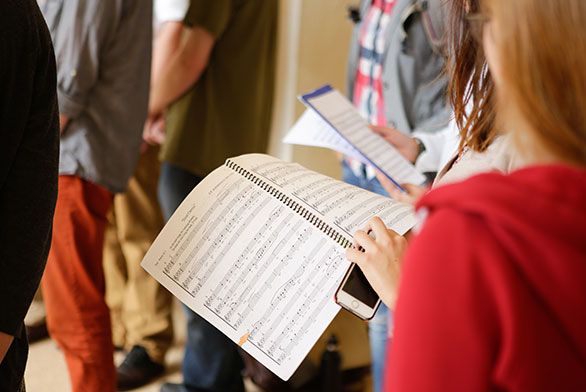From Palestrina's 'Sicut Cervus' to Campus Bands, Music Plays an Essential Role at St. John's Annapolis
May 17, 2024 | By Meliha Anthony (A25)
Known for its rigorous Great Books program and discussion-based classes, it may be surprising to some that music is an essential staple of St. John’s College culture.

Melodies and rhythms saturate Johnnie life from day one of freshman year. Students, tutors, and staff joyfully serenade newly inaugurated students after their September convocation ceremony with “Sicut Cervus,” the school’s unofficial anthem by Italian Renaissance composer Giovanni Pierluigi da Palestrina.
The same intricate polyphony floods the Foucault pendulum pit and stairways of Mellon Hall during a group sing each Wednesday afternoon, a beloved weekly tradition. During freshman chorus, students perform in an assortment of languages—including ancient Greek, Hebrew, Latin, and French—and tackle compositions ranging from Mozart’s “Ave Verum Corpus” to “The Wayfaring Stranger,” a traditional American folk song.
By sophomore year, students begin grappling with the mysterious qualities of music in their music tutorial, which exposes them to music theory, history, and appreciation. “One of the thrilling things is to see students who came here because they wanted a St. John’s education … [and] they didn’t realize that musical part of themselves at first,” says tutor and music librarian Eric Stoltzfus. “But they revealed it to themselves through their life here.”
Music has a unique connection to both the literary and mathematical sides of the liberal arts, which Johnnies continue to learn through their remaining years at the college. “We have to think about how music connects with the other academic parts of the Program,” Stoltzfus says. “We find ourselves locating it very close to the mathematical arts, especially with ratios … but then we find that it’s also very much connected with language.”
But even at St. John’s—a school that celebrates reading and discussion—language has its limits. “I really honor the college, a college of words and books, to say there’s some part of us, and some part of the world of our intellectual life and human life, that words can’t quite touch,” Stoltzfus says.
For other members of the SJC community, including Annapolis Dean Susan Paalman, St. John’s emphasis on music has helped build their own relationships with it. Prior to St. John’s, Paalman’s background was in science. She began learning and then teaching music theory in the 2000s. Since then, she has taught multiple music tutorials, directed freshman chorus, and led the sophomore long music session, where students sing during an extended class on Fridays. Through these experiences, Paalman has learned to appreciate the social effect of music.
“Part of its mystery is that it connects people in a way that nothing else does,” she says. “What happens when you get 140 people in a room all singing the same note, and something about the vibrations … comes together in a way that’s so beautiful and so connecting.”
Paalman recounts COVID-era music classes, and how she would enter each online session with apprehension. That dread would melt away as she became immersed in song. “The beautiful part was that somehow we still felt connected,” Paalman says. “We were so isolated during that time but coming together through this music.”
Antonina Schlussman (A24) describes the freedom she felt upon gaining a more precise understanding of music theory. “Theory gives us this beautiful tool to describe what we’re feeling,” Schlussmans says. “Something so subjective we put into this objective language, which I find great.”
Schlussman’s interest in music was first sparked while watching a high school jazz concert. Something clicked as she absorbed the beauty of the tones and chords weaving together. “I could see that they were feeling something so immense, and I wanted to feel it,” Schlussman says.
Soon after that, she began playing the double bass, feeling drawn to its versatility. “It’s the bridge between the melody and the rhythm,” she explains. “It’s used in every genre, and [it’s] a foundational instrument that can support others as opposed to being a solo instrument.”
Schlussman did not expect that she would be able to continue her musical journey while attending St. John’s. Now, she is an avid participant in the college music scene as a member of two student bands and as a music assistant for sophomore tutorials. She is grateful for these experiences gained both within and outside the Program.
“I was pleasantly surprised when I not only was able to become a technically better musician here, but also explore what music truly is,” Schlussman says. “I very much like the road it has taken me … that is very much due to the open-mindedness that a St. John’s education fosters.”

